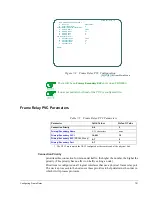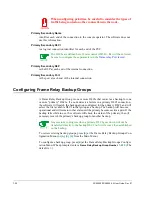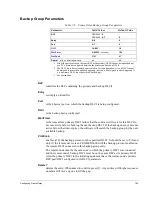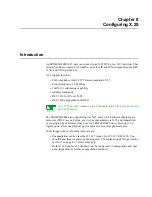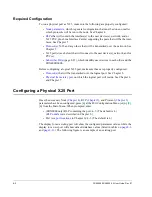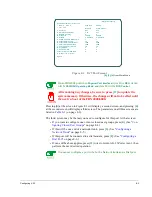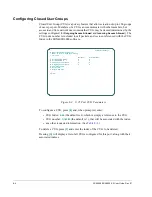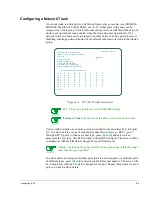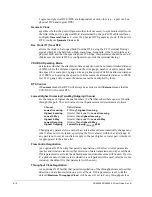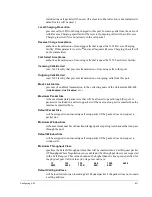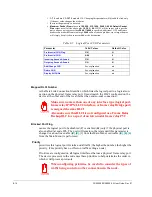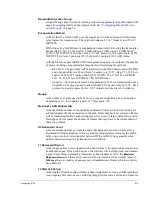
8-10
FRX4000/FRX6000 4.0 User Guide, Rev 01
Logical and physical DCE/DTE are independent of each other (e.g., a port can be a
physical DCE and logical DTE).
Generate Clock
specifies whether the port will generate the clock necessary to synchronize traffic over
the link. If the port is a physical DCE (determined by the port's I/O cable interface),
configure
Generate Clock
as
Y
, since the physical DCE generates clock. If the port is
DTE, configure
Generate Clock
as
N
.
Rcv Clock (TT) from DTE
allows the clock to be looped back from the DTE using the TT (Terminal Timing)
signal, which can be helpful on high-speed lines. Generally, if the local interface is
physical DCE and the line speed is above 256 Kbps, this parameter should be set to
Y
.
(Make sure the remote DTE is configured to provide the terminal timing.)
CSU/DSU Operating Mode
determines whether the attached modem connection can be normal or limited distance
(LDM), where the distance depends on the wire gauge, number of splice points, and
line speed. For example, 26 gauge wire and a line speed of 64K bps allows a distance
of 15000 feet. Lowering the speed to 56K increases the allowable distance to 18000
feet. If 19 gauge wire is used, the distances can be multiplied by three.
RTS Control
if
Constant
means that RTS will always be asserted, and if
External
means that the
CSU/DSU will control RTS.
Lowest/Highest Incoming/Two-Way/Outgoing Channel
are the ranges of logical channel numbers (LCNs) that subscribers can use for calls
through this port. The valid values for each parameter are determined as follows:
Channel
Valid Values
Lowest Incoming
1
through
Highest Incoming
Highest Incoming
Greater than/equal to
Lowest Incoming
Lowest 2-Way
Greater than
Highest Incoming
Highest 2-Way
Greater than/equal to
Lowest 2-Way
Lowest Outgoing
Greater than
Highest 2-Way
Highest Outgoing
Lowest Outgoing
through
4095
Changing any parameter to a value that violates this order automatically changes any
other values now in violation, specifying the first value(s) within the valid range. If
any pair is not used, its constraints apply to the next higher or lower pair (whichever
is appropriate) in the above list.
Flow Control Negotiation
is an optional X.25 facility that permits negotiation of the flow control parameters
(packet and window sizes for either direction of data transmission) on a per call basis.
If this parameter is set to
N
, the default packet and window sizes will be used. If set to
Y
, a packet and/or window size included in a call packet will be used. (If either is not
included, the default for that parameter will be used.)
Throughput Class Negotiation
is an optional X.25 facility that permits negotiation of the throughput classes for either
direction of data transmission on a per call basis. If this parameter is set to
N
, the
default (
Maximum Throughput Class
) will be used. If set to
Y
, any throughput class
Содержание Netlink FRX4000
Страница 2: ......
Страница 16: ...xiv FRX4000 FRX6000 4 0 User Guide Rev 01 ...
Страница 17: ...Section I Getting Started ...
Страница 18: ......
Страница 24: ......
Страница 37: ...Section II Configuration ...
Страница 38: ......
Страница 52: ......
Страница 78: ......
Страница 106: ...7 24 FRX4000 FRX6000 4 0 User Guide Rev 01 ...
Страница 142: ...8 36 FRX4000 FRX6000 4 0 User Guide Rev 01 ...
Страница 186: ......
Страница 216: ......
Страница 266: ......
Страница 273: ...Section III Operation ...
Страница 274: ......
Страница 296: ......
Страница 324: ......
Страница 376: ......
Страница 377: ...Section IV Appendices ...
Страница 378: ......
Страница 384: ......
Страница 390: ......
Страница 396: ......
Страница 400: ......
Страница 405: ...Menu Structure E 5 ...
Страница 406: ...E 6 FRX4000 FRX6000 4 0 User Guide Rev 01 ...
Страница 425: ......
Страница 426: ......


